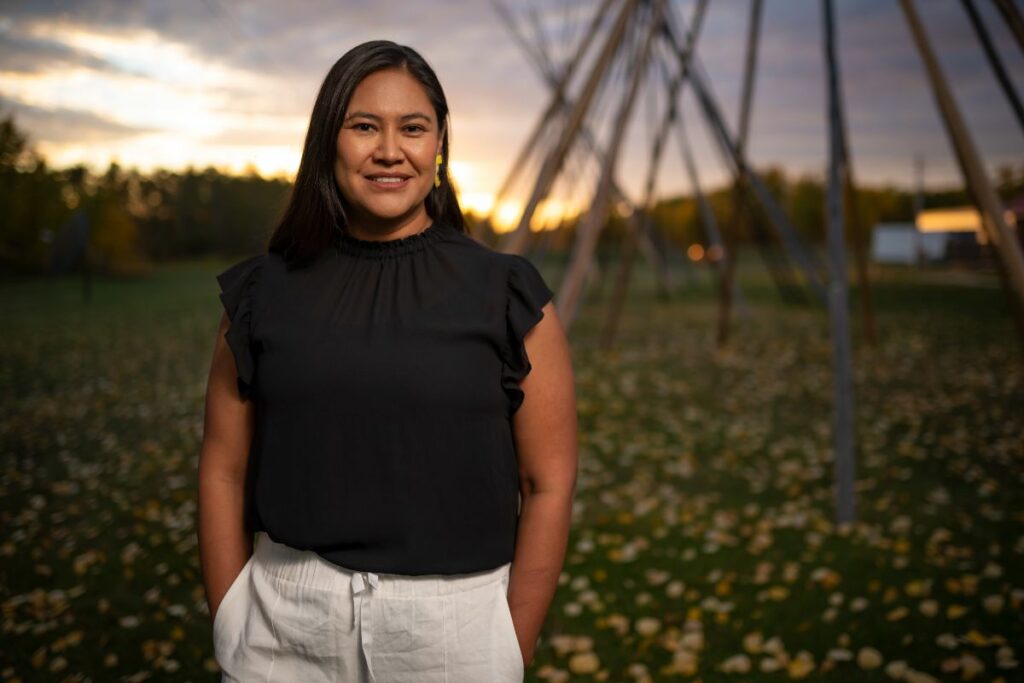This spring, RhPAP welcomes a new board of director: Dr. Nicole Cardinal. In conversation with Rural Health Beat coordinator Lorena Franchuk, the rural family physician reflects on how her upbringing on the Saddle Lake Cree Nation helps her connect with patients in northeastern Alberta.

LF: Why did you decide to study medicine?
NC: I always wanted to work in the health field. When you’re younger, you don’t know the options out there or the different jobs in health. I had encouragement from university professors and friends which helped me realize that medicine was an option. I reached out to the Indigenous Health Initiatives Program at the University of Alberta and the student support worker walked me through the process and encouraged me to apply to medicine as well.
LF: Where did you study to become a physician?
NC: I did my undergrad Bachelor of Science degree at Concordia University of Edmonton, then I did my medical degree at the University of Alberta. I finished my medical residency in Prince Albert, Saskatchewan with the University of Saskatchewan.
LF: When did you start practising and where?
NC: I did some locums (temporary fill in for other doctors) in northern Saskatchewan and then I eventually made my way toward Alberta and Saddle Lake in 2015.
LF: In what capacity are you currently practising?
NC: I work in St. Paul, providing emergency room coverage and long-term care. I work at my medical clinic at the Saddle Lake Healthcare Centre.
LF: What is it like practising in a rural Indigenous community? How does your background help?
NC: It can be a little complicated navigating the health care system on reserve. The patients are often more complex because they have underlying health issues and social issues that affect their health. I also have to be mindful of the determinants of health such as housing, food security, clean water and so on which directly affects the health of my patients. Navigating other systems like non-insured health benefits such for patients is another challenge. Another issue I encounter is the distance to specialists which makes referrals for patients difficult due to lack of transportation.
My patients also have trauma from residentials schools, the 1960’s Scoop, foster care and other difficult backgrounds. Due to the historical impacts of colonization, my patients have higher rates of depression/anxiety/PTSD/ trauma. I find that I do a lot of counselling, listening and getting to know my patients and their family. It’s rewarding for me in that I really understand where my patients are coming from. I also grew up in a First Nation community and understand the background my patients are coming from. They are able to trust me, knowing who I am. We’re more community oriented.
LF: Why did you choose to join the RhPAP Board of Directors?
NC: I wanted to be able to add a different perspective, which is being an Indigenous physician working in a rural community and working with Indigenous patients on reserve. I also enjoy rural medicine and like to share my advocacy for rural health.
LF: Did you have any support from RhPAP during your training? If so, what impact did it have on you?
NC: RhPAP was able to provide free housing accommodation so I was able to bring my husband and two kids (she has since had a third child) on my elective to Cardston, Alberta. Dr. Esther Tailfeathers was a physician who returned to practise in her home community on the Blood Tribe and she was a role model for me. Without RhPAP, I don’t think I would have been able to have that mentoring or experience. The accommodation support prevented me from being torn and having to choose between the educational experience and my family.
LF: You are one of three physicians practising within the community of 7,000 people. You also wear a lot of healthcare hats outside of your practice including as a clinical lecturer in the Postgraduate medical education in the U of A’s Faculty of Medicine and Dentistry. What other healthcare initiatives are you involved with?
NC: I am a council member on the College of Physicians and Surgeons of Alberta and I hold a position with Alberta Health Services as one of the physician leads for Indigenous wellness care for the northeast zone. I also participate on other advisory committees which focus on Indigenous health.
LF: What advice do you have for anyone interested in becoming a rural practitioner?
NC: The biggest thing that I find enjoyable is the variety of work that I can do in one day—I’m not stuck just doing one thing. I also enjoy learning, practising rural medicine—you are always learning something new. You need to know a bit about everything. If you like to learn and be challenged, practising medicine in a rural community is a good place to have those experiences.
LF: What advice do you have for Indigenous people interested in a career in healthcare?
NC: Part of it is having that exposure to medicine and having your own role model to know that others have gone through the process. Encourage students to pursue higher education and explore all the opportunities that are out there. I tell students that if they’re interested in medicine that it is a tough program but if you’re really committed to it and you have a good support system, then you will do well.
